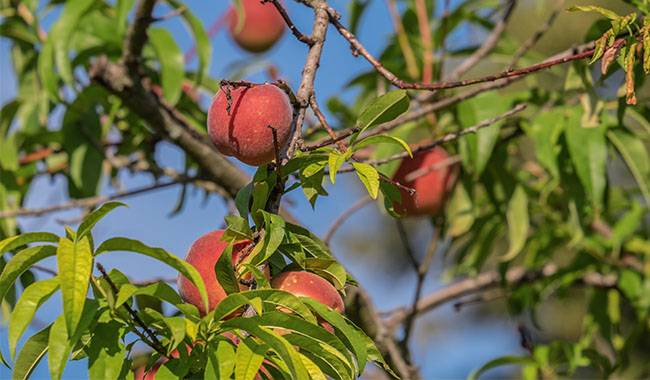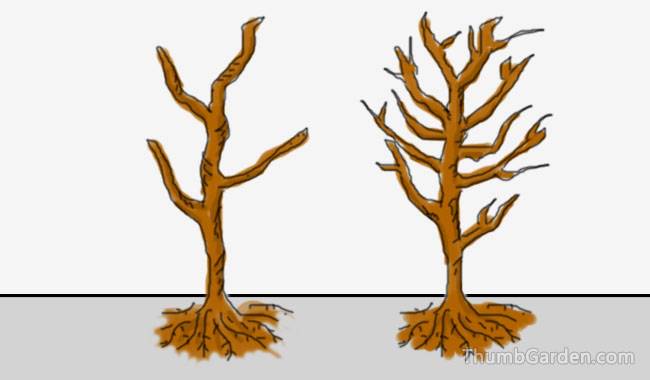
It is well known that peach trees need to be pruned annually. However, the beginner of gardeners do not fully understand the rules in this agricultural technique. Uncertain of their knowledge, amateur pruners are afraid to cut off the excess, preferring to leave more branches.
But this is unacceptable. How to form a high-yielding tree? When to perform spring pruning of peach trees?
What is “green action”? How to extend the life of a peach orchard and preserve its fruit-bearing potential? We will tell you about this in the article.
THE METHOD OF FORMING PEACH TREES – “BOWLS”
Although the peach tree has long since ceased to be a purely southern crop, the largest proportion of its plantings are still in the warmest climatic zones. In this regard, among the various methods of forming its canopy, the palm tree belongs to the “bowl”, sometimes referred to as the “vase” or “modified bowl”.
The difference is that the simple “bowl” has 3-4 well-developed skeletal branches emanating almost from one point, while the “improved bowl” – the same number of branches but with 6-8inch (15-20 cm) steps from each other – gives the peach tree a stronger skeleton and provides better ventilation and lighting for the canopy.
PRUNING PEACH TREE SEEDLINGS
Peach tree bowl crown formation begins immediately after planting seedlings by pinching the trunk at a height of 20-30inch (60-70cm) or from the 2nd year when the first skeletal branch on the tree is left at a distance of 15-20inch (40-50cm) from the ground.
Selected shoots are shortened by a few buds 13-18inch (35-45 cm) so that the outermost buds extend outward, preferably with all branches facing the same direction.
All excess shoots are cut off into a loop. The central branches of the peach tree are cut off above the upper skeletal branches. In doing so, all shoots left behind should point in different directions so as not to overlap each other.
In the third year, on each scaffold branch of the first order, leave two branches of the second order, preferably 10-15inch (30-40 cm) apart.
One of them should point to the right and the other to the left, again, to avoid lumping of the main branches, their orientation scheme should ideally be the same.
The main purpose of the first pruning of a peach tree is to form a strong skeleton of the tree.

PRUNING AN OLD PEACH TREE
Pruning an adult, the well-established peach tree is done in several ways.
The first is sanitary pruning. Remove diseased, broken, wilted branches, twins, fat, ground pointing, and shoots in the “bowl”.
Peach trees do not like thickening but respond well to crown ventilation and skeletal branch heating. For this reason, when pruning, open to the sides and do not cut thinly.
Second – ration pruning. For those who are not familiar with the peculiarities of this culture, it is most incomprehensible (and therefore – painful).
Peach trees not only densely form new shoots but also nurture buds. A mature tree may bear more than 1000 fruits!
However, when the yield is too abundant during maturation and this crop is not good at shedding excess ovaries, the tree is severely depleted, does not have time to prepare for winter, is more prone to disease, and often dies, and even if it survives, it loses much of its fruit-bearing potential.
Therefore, when quantitatively pruning, thin branches should be shortened, leaving only 1-2 flower buds, and well-developed branches (diameter of a pencil) should be left with 6-8 flower buds.
In this case, the reference point for pruning should not be the flower, but the growing bud, which will form new growth in the summer. Again, this bud should run to the right or left, but not upwards, and in the long run, it should not lead to overlap with adjacent buds, which is good.
In addition, since peach trees tend to carry the harvest to the periphery of the canopy over the years, which is not only inconvenient in terms of harvest but also leads to crushed fruit, reduced quality, and rapid tree aging, it is also important to form the canopy at height during spring pruning, removing the upper skeletal branches and shifting the harvest to a lower level. Leave the maximum height of the “bowl” within 8-10 feet (2.5-3 m).
When checking pruned peach trees, all scaffold branches and their closures (at any stage of crown formation, albeit in the 2nd or 10th year of life) should have the maximum equivalent height – the edges of the “bowl” should be aligned and not have so-called “cocks”. Otherwise, branches that remain taller than others will receive a greater inflow of nutrients and begin to compete more aggressively with other branches in their development.
WHEN DO I START PRUNING MY PEACH TREES?
Spring pruning of peach trees starts very late when everything in the garden has been pruned. The time to prune is marked when you can clearly identify a bud or pink flower bud. This usually happens when the temperature is consistently above 41°F (5°C) and in April.
Sometimes it is better to prune a little too late (but not too much, to finish before the end of the flowering period) than to rush, and peach trees are not afraid of that.
This is due to the fact that the flowering period of this cultivation is quite long, ranging from 10 to 25 days (depending on the cultivar), and that on one branch it is possible to observe both buds ready to open and fully opened flowers and ovaries.
This is important because the swollen buds of peach trees can withstand frosts of -9°F (-23°C). Flowering buds may drop to 39°F (4°C). Ovaries die at 28°F (-2°C).
Therefore, if pruned too early, buds left on shoots will flower more amicably and have a chance to die amicably if they are affected by a return frost.
What’s more, so will the ovaries. Late pruning of peach trees delays the completion of flowering to some extent and allows you to reinsure against a complete loss of harvest.
In addition, at the stage of rosebuds, it is already well known where the buds that can send out lateral branches are located. This will allow the correct formation of replacement buds and the tree will be harvested next year.
Pruning of peach trees is best done in calm, sunny weather. Always disinfect saws and pruning shears before use to avoid infected cuts. After pruning, treat large wounds with garden varnish.
SUMMER PRUNING OF PEACH TREES
In fact, summer pruning of peach trees is called “green operation” and is not only carried out in summer but in several stages, at least three times: in May, early July, and later in August.
During this period, all green shoots, fat, forked twigs growing within the canopy are removed. This ensures the lighting of the scaffold branches, improves the ventilation of the peach canopy, saves the tree from the development of unnecessary branches, enhances the laying of fruit buds for next year’s harvest, and accelerates the ripening of fruit and wood. And it is not unimportant to reduce the number of spring works.
At the same time, young plants are not cut down in the summer. From the second year until the beginning of the fruiting period, they are formed only slightly. However, the unloading of adult plants accounts for 40-50% of the total mass of the annual growth.
In addition, the green action includes repeated rationing of the harvest. Experienced gardeners thin the ovaries of peach trees during their first green forming period, leaving 4-6inch (12-15 cm) between the fruits.
This increases their quality and taste quality. And later in the ripening period, pruning the green shoots above the last fruit redirects the flow of nutrients and accelerates the ripening of the fruit and wood.
PRUNING TO REVITALIZE PEACH TREES
There is a perception that the peach tree is a low-living variety. However, with proper care, it can flower and fruit intensively for up to 20 years, and under particularly favorable conditions, even longer.
To ensure that after 7-8 years of development, when growth becomes below 12inch (30cm), the tree is rejuvenated by removing all branches above the second and third-order. After pruning, nutrition and watering are necessary.
A second rejuvenation pruning, but now on 4-5-year-old wood, is done at 15 years of age.
WHY IS THE PRUNING OF PEACH TREES A MUST?
Annual pruning not only ensures the formation of a high-quality peach tree harvest but also extends its life, provides disease prevention, increases resistance to cold temperatures, promotes its rejuvenation, stimulates growth, and gives you control over the height of the tree.
If rejected – the harvest shifts to the periphery of the canopy, the fruit becomes shallow and unpalatable, and the peach tree soon becomes old and dead. Therefore, when faced with the choice of whether or not to prune, it is best to lean toward pruning, even though it may not be very professional.



